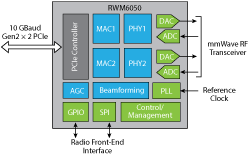
As mobile operators continue to trial various technologies, it seems clear that 5G deployments will begin with fixed broadband wireless access in the millimeter wave (mmWave) band. This is driven by the large amount of spectrum available in both licensed and unlicensed bands, and the maturity of technologies that facilitate mmWave solutions. The combination of advanced wireless signal processing technology and the extensive spectrum available increases the bandwidth capacity of infrastructure networks that will offer the end user an immediate increase in data rate. This increase in capacity benefits operators by generating additional revenue from new business models built around various 5G use cases, such as virtual reality, real-time distributed ultra-high definition gaming and tactile internet for remote surgery.
FIXED BROADBAND ACCESS
Operators today offer fixed wireless access via fiber, DSL, cable, wireless and satellite media, which have data rates between a few and 100s of megabits per second (Mbps), depending on the location and the access technology. For example, xDSL offers data rates in the range of 100s of Mbps. However, the services are geographically challenged and cannot uniformly guarantee the required quality of service or throughput over distance in both urban and suburban areas. Satellite access technology, on the other hand, has the potential to cover remote areas and is able to reach 100s of Mbps, based on the DVB-S2x specification. However, due to the inherent delay in geostationary earth orbit (GEO) satellite networks, this type of fixed access service will always have limitations. Among all the available technologies, an end-to-end fiber network offers multi-gigabit fixed access to the user today. A fiber network’s biggest hurdle is delivery of that fiber access to the end user. In communities where fiber is nonexistent, it can be time-consuming and costly to deploy, resulting in operators experiencing long delays in realizing a return on their investments. In most cases, the fiber is never seen at the end user’s location; the fiber based link is terminated at a central hub, and the “last mile” access is provided by either xDSL or wireless.


Figure 1 IDT mmWave modem block diagram.
During the last several years, wireless technologies and spectrum allocation have seen radical changes. In particular, the availability of mmWave spectrum from 26 to 90 GHz has opened significant opportunity to deliver multi-gigabit wireless access to the user. For example, in July 2016, the FCC opened up around 3.85 GHz of licensed spectrum between 27.5 and 40 GHz (i.e., 27.5 to 28.35, 37 to 38.6 and 38.6 to 40 GHz). The FCC also added 7 GHz of spectrum in the unlicensed V-Band (64 to 71 GHz) to the existing unlicensed V-Band spectrum (57 to 66 GHz). Ten GHz of spectrum is available in the lightly licensed E-Band (71 to 76 and 81 to 86 GHz). In total, this provides nearly 28 GHz for radio access technologies (see Table 1).
The access to spectrum is an important first step to enable wireless technology as a solution for fixed access networks. The second “wave” or step is the significant technology advancement in antenna design and wireless communications protocols, based on beamforming and phased arrays for mmWave channels. Lastly, fueled by an industry-driven ecosystem and standardization bodies such as Wi-Fi Certified WiGig, IEEE 802.11, ETSI ISG mWT and 3GPP, there have been considerable improvements in signal processing techniques that have created opportunities for commercially feasible mmWave solutions.
mmWAVE MODEM
IDT recently introduced mmWave-based wireless modem technology to address the emerging fixed broadband wireless market (see Figure 1). The solution closes the last mile gap for 5G and offers a true multi-gigabit wireless fiber experience for the end user. The modem technology offers a range of innovative features such as beamforming, channelization and flexible medium access control schemes. With these features, operators and network equipment manufacturers can take advantage of the large wireless spectrum available in the mmWave band and offer real-time 5G services in an interference limited environment, expected in the unlicensed band. The solution is equally applicable to the licensed mmWave bands (e.g., Ka-Band) and can enable multi-gigabit solutions based on higher order modulation and strong forward error correction (FEC) schemes such 64-QAM and low-density parity-check (LDPC) encoding, respectively.

Figure 2 Mesh network example for fixed wireless broadband access.
Operators benefit from a simplified deployment model enabled by a range of network topologies offered by the solution. For example, the dual modem architecture with support for time-division duplex (TDD) and frequency-division duplex (FDD) allows operators to deploy fully redundant wireless fixed broadband access for home and enterprise users in both mesh and hub-spoke architectures. With support for beamforming with phased-array antennas, operators can design a scalable sectorized cell architecture of varying sizes, as the number of users grow over time. Figure 2 illustrates an example topology of a multi-gigabit fixed wireless broadband access mesh network based on the mmWave solution.
Deploying multi-gigabit speeds to the last mile needs to be practical and profitable. The greatest advantage both operators and network equipment manufacturers will experience is the speed and low cost to deploy a RapidWave-based module. A chipset including the RapidWave modem paired with a mmWave phased-array front-end provides critical functionality, including digital beam alignment and sub-channelization, that accelerates the deployment and simplifies frequency planning, even in densely distributed networks.
Nearly 28 GHz of new mmWave spectrum, algorithm and antenna technology advancements and standardization have enabled new innovations, such as the RapidWave modem, that will fuel the 5G vision of multi-gigabit fixed broadband wireless access.
Integrated Device
Technology Inc.
San Jose, Calif.
www.idt.com
